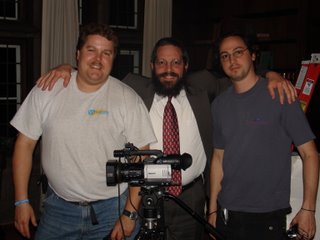Hi all. Long time. So much for a “daily” blog. How about a semi-annual one?
I tend to be overly ambitious, and sometimes have trouble living up to my self-imposed own expectations.
We are a little more than half way through the summer, and things are coming along with Agent E 5. I have a rough cut done – at least with the material that is already filmed (“in the can”, as the saying goes).
There still remains a very big scene to do – which even has a date attached to it: Tuesday, August 22. Modi will be returning to Pittsburgh the day before, and we will go into the recording studio to record the music we will be lip synching to the following day.
You see, this new Agent Emes ends with a big concert scene where we will hear Agent Emes (and others) sing. The working title (and probably the final one as well) is “Agent Emes and the Happy Chanukah” It looks as though it will have a running time of over 50 minutes, making it the longest episode to date.
Here’s how the editing process works:
After filming our scenes, we are left with miniDV tapes containing the “raw footage” of all the takes for all the scenes. As mentioned in a previous blog, the editor (myself in this case) must separate and import (“log the footage”) into the computer. I use the Macintosh system and the incredible editing software called Final Cut Pro.
Once all the footage is in the computer, separated into individual takes, I then begin the process of selecting the best ones and pasting them all together into a comprehensible narrative. Since I wrote the script and am intimately familiar with the story, I don’t have to rely on notes as much as an editor who did not write and direct would. I basically know how the shots should go together to tell the story.
However there are always complications to deal with. As I say, the best performances must be chosen. But these takes must flow together from long shot to medium shot to close up as smoothly as possible. Sometimes the best performances don’t cut together so well. Or sometimes the first half of a take might be great, and the second half will have a major breakdown. So the editor must find a way to put two or more versions together to make one good one. There is quite a bit of slight of hand involved in editing.
At this juncture, I have cut together the entire episode (minus the material that has not yet been filmed), and I am pleased with the way it is turning out. It so happens that this episode is the most special effects intensive to date, so I have taken on an assistant to help create the lightsaber effects we need for two big fight scenes between Dr. Lo-Tov and Agent Emes. My assistant is a fifteen year-old boy who is very quick to pick up the techniques necessary to pull of the effects. I would mention his name, but since I don’t have his permission, I won’t. Those of you who have seen previous episodes would recognize him as the boy who played the part of “Yoni”. He is really doing a great job, but there is a LOT more to do, school starts up again in three weeks, and he is on vacation this week in Alaska.
The rest of the effects will done either by myself, or the same person who did effects on previous episodes.
Once I am happy with the flow of the edited film, the next step is to make corrections on the picture. This process is called “Color Correction.” Without boring you with details, this involves lightening, darkening, and changing the color balance of individual shots so that they match within a scene, and do not create distracting discrepancies. In other words, if one shot is tinted green, and the next one is reddish, the viewer sees this (maybe only subconsciously), thus creating an imposition to the viewing process. It takes the viewer “out” of the story, so to speak.
Next comes the music and sound editing.
I am beginning to bore myself. Suffice to say that this all takes a lot of time. And since we are not a mult-million dollar production, I have to do most of it myself.
We are still looking at a target release date for mid-October 2006, but I don’t want to make any promises.
More to follow.



